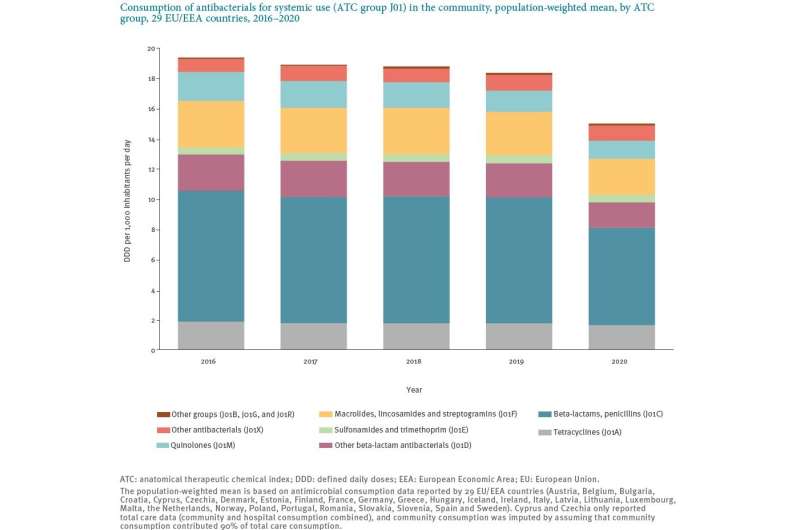
On the occasion of European Antibiotic Awareness Day (EAAD) on 18 November and the start of World Antibiotic Awareness Week, new data from the European Centre for Diseases Prevention and Control (ECDC) published in Eurosurveillance show that antibiotic consumption in the community decreased by more than 18% between 2019 and 2020.
This decline, noted by the authors as the largest annual decrease in the two decades of reporting via the European Surveillance of Antimicrobial Consumption Network (ESAC-Net), was observed in 26 of the 27 reporting countries of the European Union and European Economic Area (EU/EEA). Changes were largest and most consistent in the primary care sector, most likely as a result of the COVID-19 pandemic.
In the rapid communication published today in Eurosurveillance, Diaz Högberg et al. analyzed the consumption of antibacterials for systemic use. From 2016 and 2019, the EU/EEA population-weighted mean annual change in the consumption of antibacterials for systemic use was −0.34 defined daily doses (DDD) per 1,000 inhabitants per day, representing a 1.8% annual decrease (median: −0.44 DDD/1,000 inhabitants/day or a 2.3% annual decrease). Between 2019 and 2020, the decrease was 10 times higher, declining by −3.35 DDD/1,000 inhabitants/day. This represents a 18.3% decrease between 2019 and 2020.
Overall decline in consumption of penicillins and beta-lactams
The 26 countries that reported an overall decrease in consumption of antibacterials showed a decline in consumption of penicillins between 2019 and 2020, as well as reduced consumption of other beta-lactams (including cephalosporins, macrolides, lincosamides and streptogramins).
According to the authors, possible reasons for the decrease could be a general drop in the number of primary care consultations during the COVID-19 pandemic, as people were more cautious to seek healthcare for mild or self-limiting infections, or due to difficulties in getting medical appointments.
The authors also hypothesize that “the large decrease noted for antibiotics commonly used to treat respiratory tract infections, e.g. penicillins and other beta-lactam antibacterials, is in line with the reported low incidence of non-COVID-19-related respiratory tract infections in the EU/EEA in 2020. This has been attributed to the non-pharmaceutical interventions put in place as a response to the pandemic, including physical distancing, respiratory etiquette, face masks and promotion of hand hygiene.”
As exposure to antibiotics is associated with the emergence of antibiotic resistance, the overall uptake and how antibiotics are consumed in a population has an impact on antibiotic resistance. Prior to the COVID-19 pandemic, the primary care sector accounted for about 80% to 90% of all antibiotic prescriptions, mainly for respiratory tract infections.
Source: Read Full Article